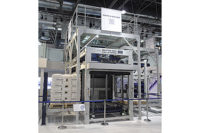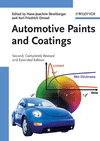Recent Developments in Bulk Bag Fillers and Dischargers

Except for a very few applications, gone are the days where a company asks a local fabricator or their own engineering team to concoct a bulk bag support frame – whether to fill or empty. The worldwide acceptance of bulk bags has resulted in tremendous changes in bulk material handling practices. In some instances, even the pharmaceutical industry now uses bulk bags to replace rigid intermediate bulk containers (IBC) since their associated filling and discharge systems offer them proven advances in a hygienic and “high-containment” operation. Bulk bags also eliminate the need for cleaning and re-validation procedures.
Specialist suppliers, such as Spiroflow Systems, offer bulk bag filling and discharge systems with high levels of containment. ‘Homemade’ fabrications can never match the safety, reliable discharge and containment demanded by today’s industrial practices and required through current legislation.
This article reviews some of the advances made in bulk bag discharge and filling, and offers points to consider when selecting a discharger or filler for your plant.
Bulk Bag Discharging
There are a number of companies that offer bulk bag dischargers as an accessory for other equipment. Given the potential for problems with all but the freest flowing of materials, it is essential to select a supplier for whom bulk bag dischargers are a key product line. Following are some recent developments in bulk bag discharging offered by specialist suppliers.High-Hygiene Clamping Device
One recent development by Spiroflow is an upgrade of its high-hygiene liner clamping device. Loose liners in bulk bags can pose problems for processors and can be the cause of dust and spillage during both discharge and disposal when the bag is empty. Spiroflow offers a liner spout clamping system that assures total containment of the bag contents. A two-way process, containment prevents exposure of the operator and the environment to hazardous products, and conversely ensures that neither the operator nor the environment contaminate the product.The new clamping device only requires a spout length of 19 in. This makes it easy for the operator to manipulate the spout into the clamping system. The clamp is operated either pneumatically or manually. The clamp may also be used for unlined bulk bags, clamping directly to the bag spout.
Previous clamping methods required a liner length of almost 35 in. This length made it more cumbersome for most operators to locate. In addition, the liner length was not always available, causing the processor to request bags with tailored liners or longer outlet spouts from the material supplier.
The hygiene spout is housed within a containment enclosure usually connected to a filtration system. Access to the hygiene clamp is through large double doors, or a glove compartment, depending on the hazard level. The containment enclosure may be fitted with an integral “safe change” HEPA filter.
During discharge, the bag and liner are kept in tension to promote a smooth flow of product and to ensure the bag is totally emptied. Tensioning also prevents distension of the bag and/or liner as well as becoming entangled with moving parts of the downstream process or integral conveyor below.
Integral Liner Clamping System
Another recent innovation are bags with an integral liner clamping system. Spiroflow’s sanitary model offers an option to accommodate such clamping systems. This is another example of the ever-increasing number of “total containment” developments for those involved in the discharge of hazardous or sensitive materials from bulk bags. The system is designed for bulk bags with formed liners, and is ideal for fine chemical, dairy, food, and pharmaceutical applications, where high degrees of containment are essential.A liner clamping system typically includes a docking seal comprised of two interlocking rings secured to the liner spout – usually custom fitted by the bulk bag manufacturer. When ready to empty, the bulk bag is lifted onto the discharge station and the liner, with the docking seal pulled down and mated with a special docking unit by way of a clamp. The bag can then be untied and the product released in a dust-tight manner with no contamination of the product, the operator or the environment.
Looplifter®
Looplifter holds the loops open of any bulk bag, allowing the forklift operator to handle the FIBC without either leaving the seat or seeking any external assistance. Looplifter allows the loops to be “squashed” downward when further bags are stacked on top. Even after lengthy compression, the loops always return to a fully open position.Other Developments
Bulk bag manufacturers are now offering bags with side ‘tunnels’ instead of loops. Side tunnels are in fact rolled-over extensions of the side panels. These also make it easier for lift truck operators to pick up a bag without manual assistance.Another development, ‘Pallet-Less’ bulk bags, is one of several innovations that make the need for separate pallets a thing of the past. Not only do ‘Pallet-Less’ bulk bags include integral forklift locations that contribute to overall hygiene, they free up more space for the product, which is particularly important when loading bulk bags into ISO containers.

Points to Consider in Selecting a Bulk Bag Discharger
In selecting a bulk bag discharger, here are 19 points to consider:1. Will the discharger handle different-sized bags?
2. Can the discharger cope with lined or unlined bags?
3. Can the bag discharge poor-flowing products?
4. Will a hoist or a forklift truck load the bag?
5. Can you control the flow once the bag is opened?
6. Do you need to tie off partially empty bags and remove them from the discharger?
7. How sure are you that the discharger will completely empty the bag?
8. Does your product need to be discharged by weight or by volume?
9. Do you need a device to restrain and/or remove liners?
10. Is an integral conveyor required to transfer product to another location?
11. Will the discharger fit into the available headroom?
12. Does the discharger need to be mobile so that it can serve more than one location?
13. Does your application need a fall-back provision to accept 55 lb (25 kg) bags if your supply of product(s) in FIBCs is interrupted?
14. Does your application have to meet the hygiene requirements of the USDA, the FDA, OSHA or other regulations?
15. What dust-control measures must the discharger include:
· When untying the bag spout?
· While the product is being discharged?
· When the liner is removed?
· When the bag is removed and folded for return or disposal?
16. Is the discharger working in a hazardous environment? Do you require electrostatic containment or monitoring?
17. Does the supplier you select have good references for similar applications?
18. Does the supplier you select have in-house testing facilities to demonstrate the effectiveness of their equipment on your product?
19. Does the supplier you select have effective spare parts and technical and engineering support programs?
Bulk Bag Filling
Some manufacturers are setting the standard for high-containment bulk bag filling. Perfectly upright and stable bulk bags can now, for example, be filled to the required weight in less than one minute. A minute is also about the time it takes to rig a new bag into position and to remove a filled bag at the end of the cycle. This typically equates to a filling rate of around 20 bags an hour. This all happens dust-free and without spillage. Upright and stable bags are essential if the bags are to be stacked, transported by highway or loaded into shipping containers at a port.A typical bulk bag filler includes many of the latest state-of-the-art developments. For example, new bag fillers are furnished with programmable controllers designed to increase filling accuracy and cycle speed. Automatic gain-in-weight systems monitor and control the filling process within an accuracy of +/- 1% These fillers are ideal for companies seeking NEPT approval.
There are also many custom features available, including:
· Retracting bag hooks that simultaneously open and close all bag hooks for fast attachment/detachment of the bulk bag loops to the filler. This makes rigging of the bag to the support frame quick and easy.
· A filling nozzle and inflatable mechanical seal between the filler and the bag for a sanitary, dust-free operation.
· Pneumatically powered support arms that let the operator adjust the height between filling cycles to accommodate various-sized bulk bags.
· Liner inflation device that ensures the integrity of the bulk bag by inflating the liner with ambient air, creating slight positive pressure to remove any wrinkles that may cause instability or subsequent difficulties during discharge. It also ensures full maximum material capacity. Air displaced through filling is vented through the annulus that surrounds the flling spout.
· Electric or pneumatic vibrators that improve material densification and compacting during the filling process for better storage and transport. This increases productivity and maximizes the use of space. Timed vibrations also occur during the weighing cycle at predetermined intervals. The vibration technique employed by Spiroflow, for example, ensures that it is exerted in the vertical plane only for maximum effect. This makes bags stable and safe to handle.
· A roller bed system that ensures faster off-loading of filled bags to increased productivity. An automatic bulk bag loop releasing mechanism enables filled bags to be automatically removed by a roller bed system. This system ensures faster off-loading of filled bags to increase productivity.
Points to Consider is Selecting a FIBC Filler
In selecting bulk bag filler, here are 15 points to consider:1. Will the filler handle different size bags?
2. Are the bags lined or unlined?
3. Are the bags going to be filled by weight or by volume?
4. If by weight, does the filler need NEPT approval?
5. Is it quick and easy to rig in new bags safely?
6. Are the bags pre-inflated before filling?
7. Is the filling process completely dust-tight?
8. Does the filler stretch the bag and compact/de-aerate the product during filling?
9. Is there a provision to vent the displaced air safely to a filtration system?
10. Can up to 20 2,200 lb (1,000 kg) bags be filled per hour?
11. Can filled bags be removed by forklift truck or conveyor?
12. Can filled bags be automatically removed after filling?
13. Does the supplier you select have good references for this and similar applications?
14. Does the supplier you select have testing facilities available to demonstrate the effectiveness of their equipment on your product?
15. Does the supplier you select have effective spare parts and technical and engineering support program?
Conclusion
There have been numerous developments in bulk bag discharging and filling over the years that need to be considered before selecting a supplier. The points to consider in selecting a discharger or filler should also be reviewed before making a final selection.For more information, contact Spiroflow Systems, Inc. at 704/291.9595, e-mail info@spiroflowsystems.com or visit www.spiroflowsystems.com.
Looking for a reprint of this article?
From high-res PDFs to custom plaques, order your copy today!






